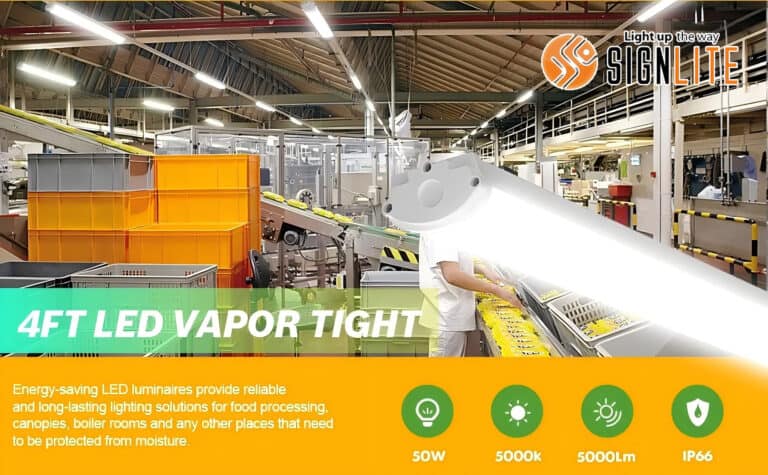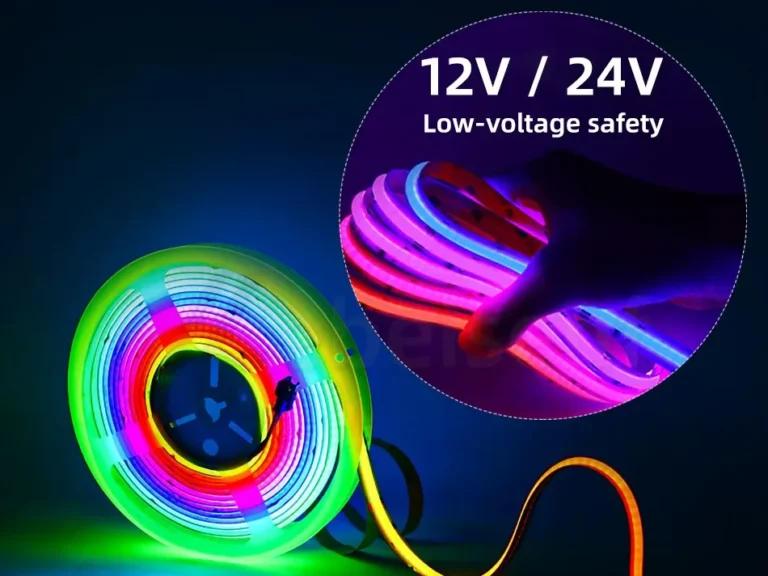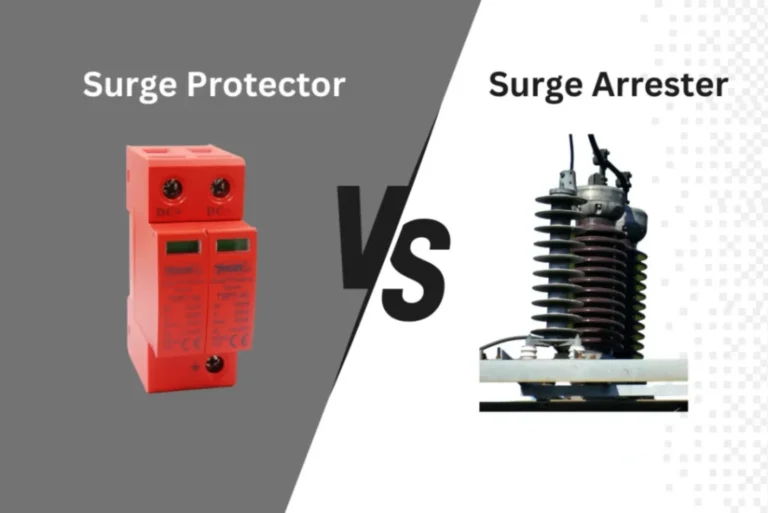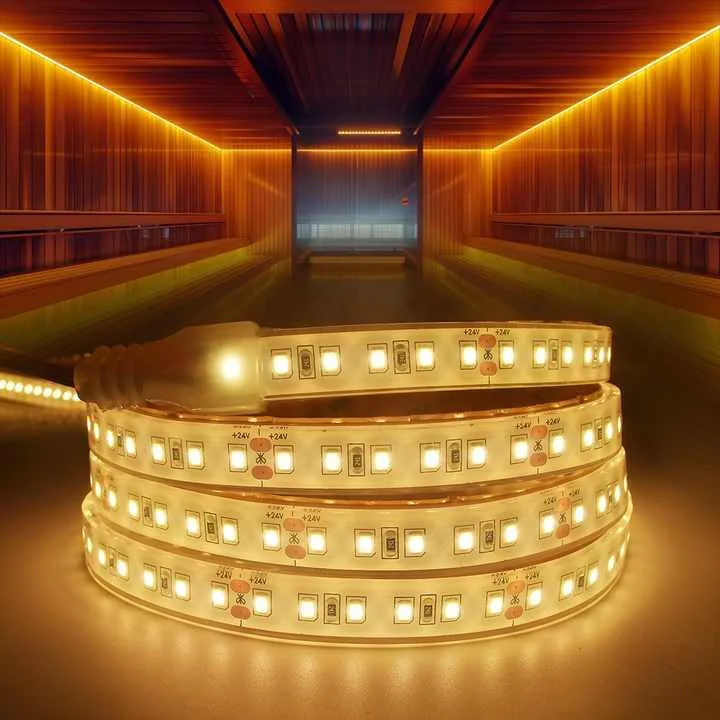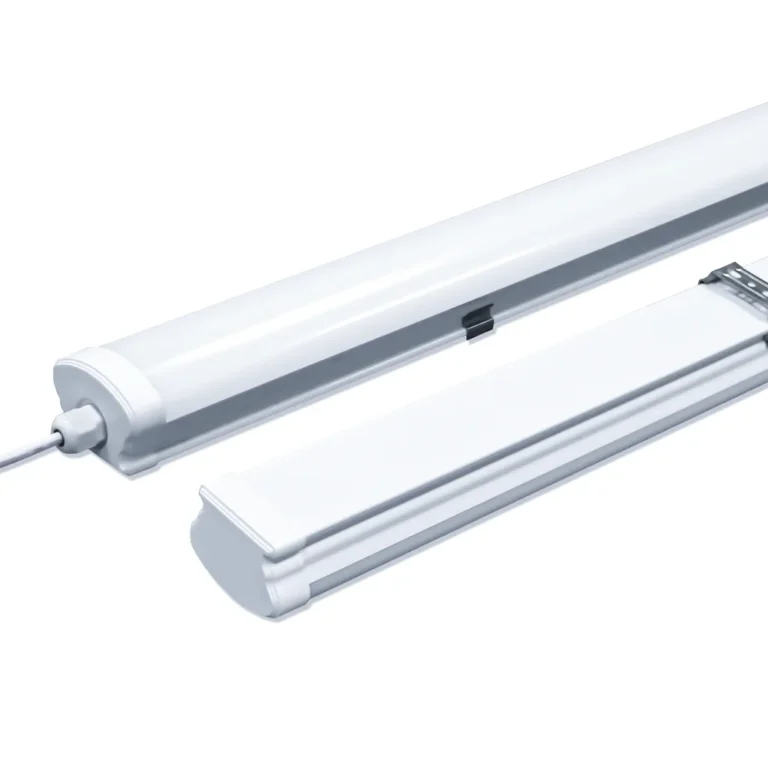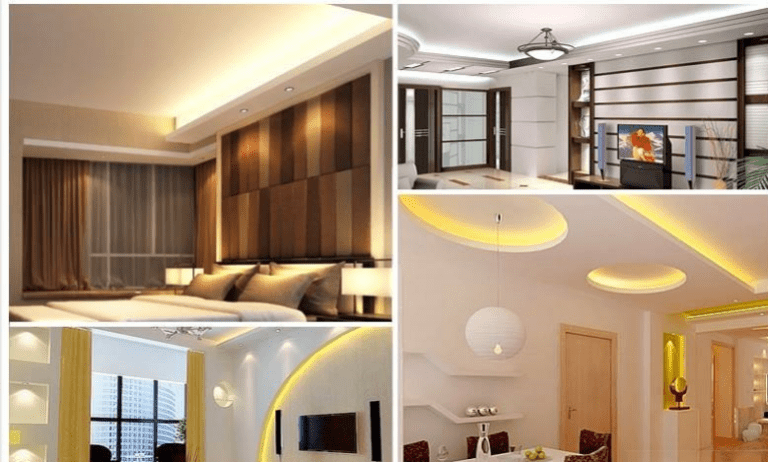Tri-Proof LED-Leuchten bieten Schutzfunktionen gegen Staub, Wasser und Korrosion. „Tri-Proof Lights“ ist ein Sammelbegriff für langlebige Beleuchtungsprodukte, die speziell für raue Industrieumgebungen entwickelt wurden. Das International Protection (IP)-Rating-System bietet ein standardisiertes Verfahren zur Klassifizierung von elektrischen Gehäusen auf der Grundlage ihrer Beständigkeit gegen diese Umweltfaktoren (Staub, Wasser und Korrosion).
Die Bewerbungsaussichten für LED-Dreifachleuchten sind außergewöhnlich breit. Sie sind nicht nur für die traditionelle Fertigung, Lebensmittelverarbeitung und Pharmaindustrie von entscheidender Bedeutung, sondern wachsen auch mit dem Aufkommen neuer Sektoren wie New Energy, Smart Cities und der modernen Landwirtschaft rapide. Daher ist die Auswahl des geeigneten Schutzniveaus für LED-Dreifachlichter nicht nur eine technische Überlegung, sondern eine entscheidende Geschäftsentscheidung, die sich auf Sicherheit, Wartungskosten und betriebliche Kontinuität auswirkt.
In diesem Blog werden drei gängige IP-Bewertungen untersucht - IP65, IP67 und IP69K -, die ihre wasserdichte Leistung, optimale Anwendungen, Implementierungsanforderungen und Kostenüberlegungen vergleichen, um Ihnen dabei zu helfen, eine fundierte Auswahl zu treffen.
Was ist eine IP-Bewertung?
Der IP-Code, der von der International Electrotechnical Commission (IEC) unter der Norm IEC 60529 festgelegt wurde, liefert klare Informationen über das Schutzniveau eines Produkts gegen Feststoffpartikel und Flüssigkeiten.
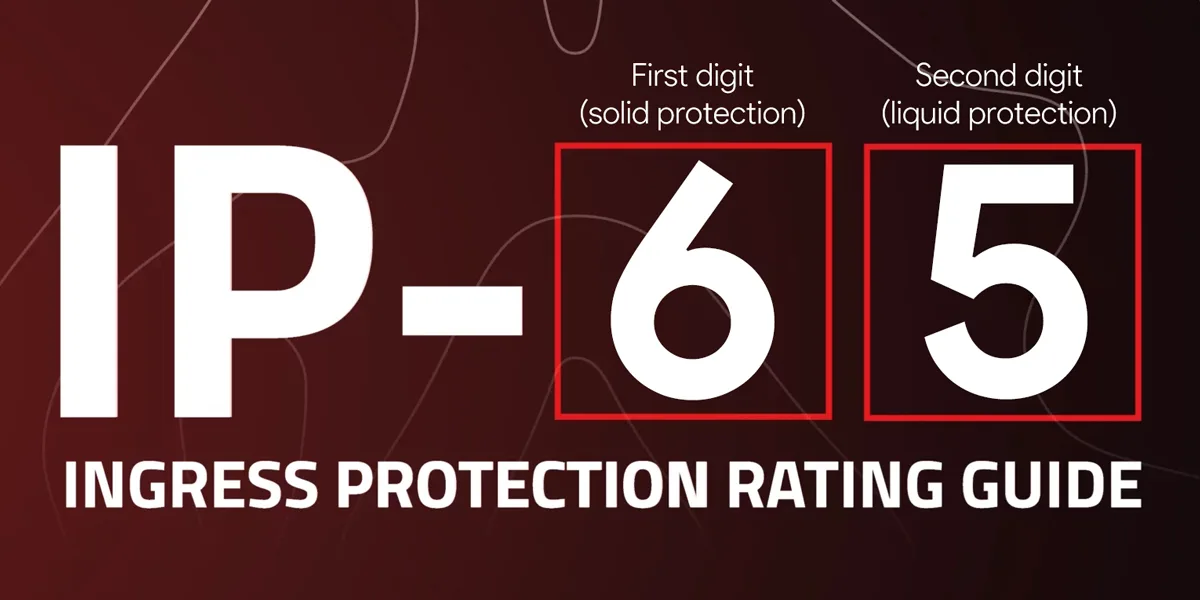
IP steht für „Ingress Protection“. Die beiden Ziffern nach den Buchstaben geben die IP-Bewertung an, die durch die Buchstaben „IP“ gefolgt von zwei Ziffern dargestellt wird. Höhere Zahlen bedeuten besseren Schutz.
- Erste Ziffer (fester Schutz): 0-6 (kompletter Staubschutz).
- Zweite Ziffer (Flüssigkeitsschutz): reicht von 0-9K (Schutz gegen Hochdruck-Wasserstrahlen).
| Ziffer | Schutz gegen Feststoffe | Schutz gegen Flüssigkeiten |
| 0 | Kein Schutz | Kein Schutz |
| 1 | >50mm Objekte (z.B. Hände) | Vertikales Tropfwasser |
| 2 | >12,5 mm Objekte (z. B. Finger) | 15° geneigtes Tropfwasser |
| 3 | >2,5 mm Objekte (z. B. Werkzeuge) | Spritzwasser (bis 60°) |
| 4 | >1mm Objekte (z. B. Drähte) | Spritzwasser (alle Richtungen) |
| 5 | Staub geschützt | Niederdruckwasserstrahlen |
| 6 | Völlig staubdicht | Hochdruckwasserstrahlen |
| 7 | – | Temporäres Eintauchen (1m, 30min) |
| 8 | – | Kontinuierliches Eintauchen (über 1m) |
| 9k | – | Hochdruck- und Hochtemperatur-Wasserstrahlen |
Was sind die IP-Bewertungen für LED-Tri-Proof-Leuchten?
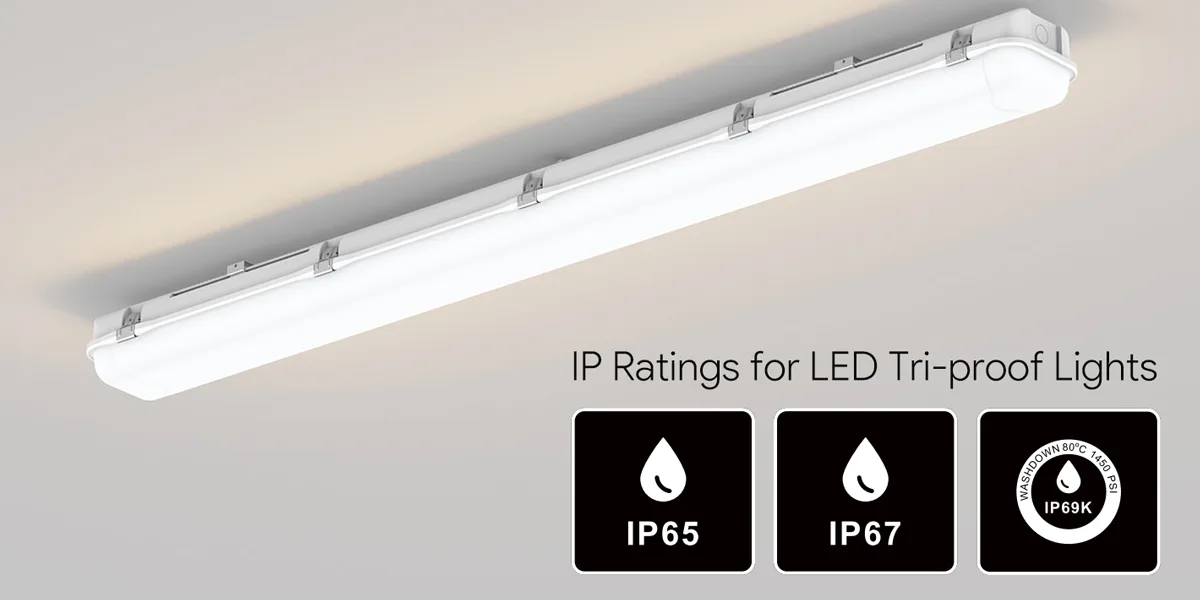
Zu den gängigen IP-Noten für LED-Tri-Proof-Leuchten gehören hauptsächlich IP65, IP67 und IP69K.
- IP65 Bietet umfassende Staubschutz und Schutz gegen Wasserstrahlen, geeignet für feuchte und staubige Umgebungen.
- IP67 Fügt dem Staubschutz eine Beständigkeit gegen kurzfristiges Eintauchen hinzu und ist unerschütterlich und regen Regen stand.
- IP69K Bietet höchste Schutzstufe, hält Hochdruckwasserstrahlen aus nächster Nähe. Es ist speziell für industrielle Umgebungen konzipiert, die eine strenge Reinigung und Desinfektion erfordern, wie z. B. Lebensmittelverarbeitung und Chemieanlagen.
Zusammen decken diese drei Bewertungen Anwendungen ab, die vom grundlegenden Schutz bis zu extremen Umgebungen reichen. Verschiedene Bewertungen passen zu Outdoor-, Industrie- oder Unterwasserszenarien und erfordern eine Auswahl basierend auf den tatsächlichen Anforderungen.
Was ist ein IP65-bewertetes Tri-Proof-Licht?
- Erste Ziffer (6): Kompletter Staubschutz
- Zweite Ziffer (5): Schutz gegen Niederdruckwasserstrahlen aus jeder Richtung
Ein IP65-bewertetes Tri-Proof-Licht bietet vollständigen Staubschutz und Widerstand gegen Niederdruck-Wasserstrahlen aus jeder Richtung. Diese Bewertung stellt sicher, dass kein Staub in das Gehäuse eindringen kann und die internen Komponenten trocken und funktionsfähig bleiben, wenn sie gerichteten Wasserströmen ausgesetzt sind.
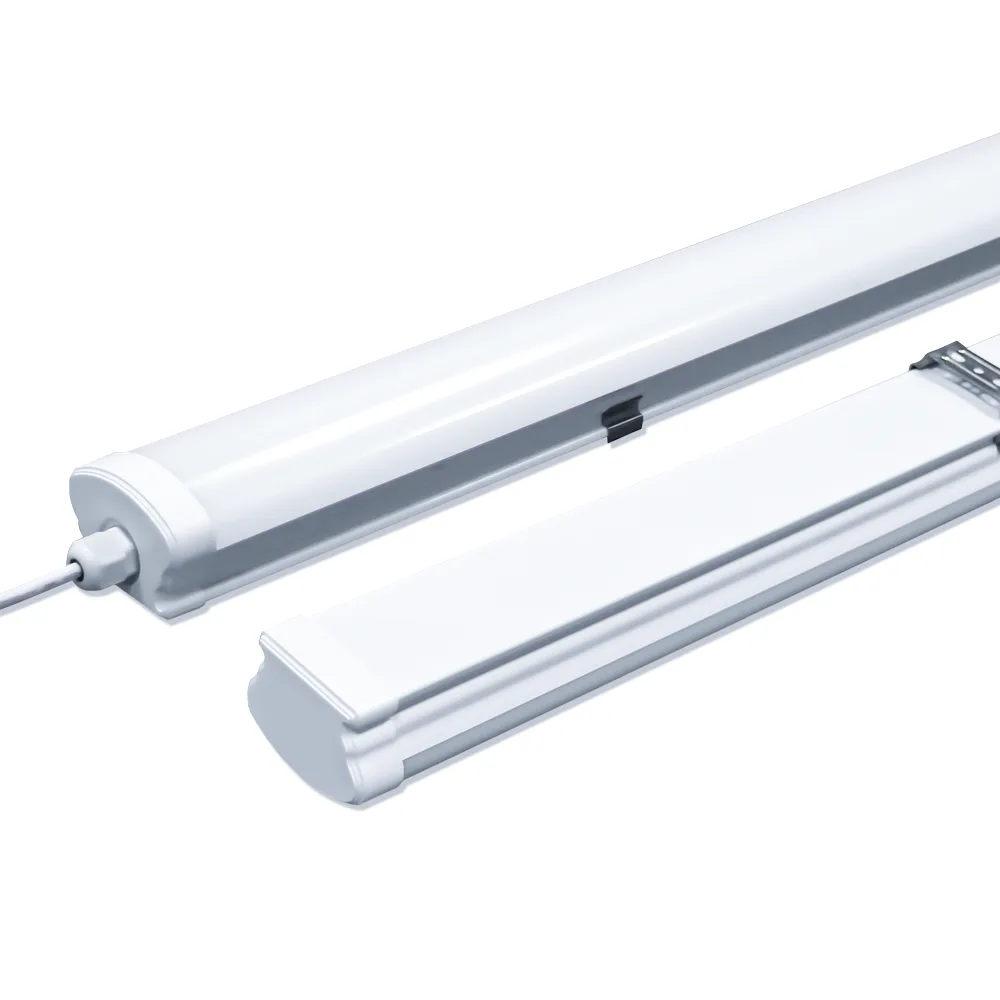
IP65 Eco LED dampfdicht
Modell-Nr: TRD06x20m/TRD12x40m/TRD15x50m
Maß: 600/1200/1500x68x48mm
Eingangsspannung: 85-265VAC, 50/60Hz
Watt: 20W/40W/50W
Lichtausbeute: 120lm/W
CCT: 3000K, 4000K, 6500K
CRI: >80
Schutzart: IP65
Dimmen: 0-10V/Triac/DALI/PWM
Zertifizierung: CE, RoHS
Garantie: 3Jahre
1. Wasserdichte Leistungs- und Testparameter
- Prüfverfahren: Düse (6,3 mm) Sprühen 12,5 Liter pro Minute bei ca. 30kPa Druck, Testdistanz 2,5-3 Meter, für mindestens 3 Minuten.
- Praktische Bedeutung: Widersteht Regen, Spritzern und gelegentlichem Waschwasser mit niedriger Druckhöhe.
2. Anwendungsumgebungen
IP65 LED-Tri-Proof-Leuchten eignen sich für allgemeine Lagerhäuser, Supermärkte, Küchen, Büros und ähnliche Standorte und profitieren von den langlebigen Materialien und der einfachen Installation und Wartung.
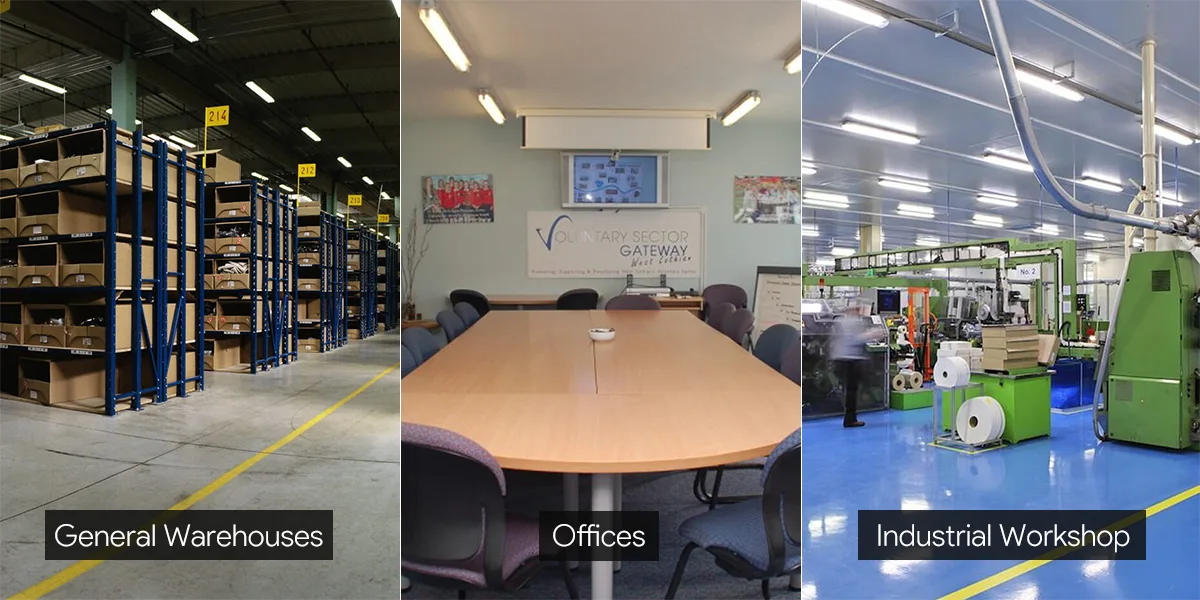
IP65 LED-Drei-Proof-Leuchten werden in feuchten und staubigen Industrieumgebungen wie Lebensmittelverarbeitungswerkstätten, Chemieanlagen und Schiffsdecks weit verbreitet. Ihre IP65-Bewertung bietet vollständigen Staubschutz und hält Wasserstrahlen mit niedrigem Druck stand und gewährleistet einen stabilen Betrieb unter Hochdruckwaschungen oder hoher Luftfeuchtigkeit.
In Außenanlagen wie Baustellen, Docks und Freiluftlagern halten IP65-Drei-Proof-Leuchten raues Wetter wie Wind, Regen und Staub effektiv stand. Ihre versiegelte Konstruktion und korrosionsbeständige Materialien verlängern die Lebensdauer der Lampe und verringern die Wartungsfrequenz.
Darüber hinaus eignen sich IP65-Tri-Proof-Leuchten für staubfreie Umgebungen wie metallurgische Anlagen und Zementfabriken. Wärmeableitungsventile im Labyrinth-Stil und Silikondichtringe verhindern Staubansammlungen, die zu einer schlechten Wärmeableitung oder einer verringerten Leuchtkraft führen können.
3. Einschränkungen und PWiederholung
Während IP65-Leuchten einen erheblichen Schutz bieten, sind sie jedoch nicht zum Eintauchen geeignet, da auch vorübergehende Eintauchen Schäden anrichten können, sie nicht der Hochdruckwäsche widerstehen können, die bei industriellen Sanitärverfahren üblich ist, und sie werden nicht für Gebiete mit häufigem direkten Wasserkontakt oder Hochwasserrisiken empfohlen.
Was ist ein IP67-Tri-Proof-Licht?
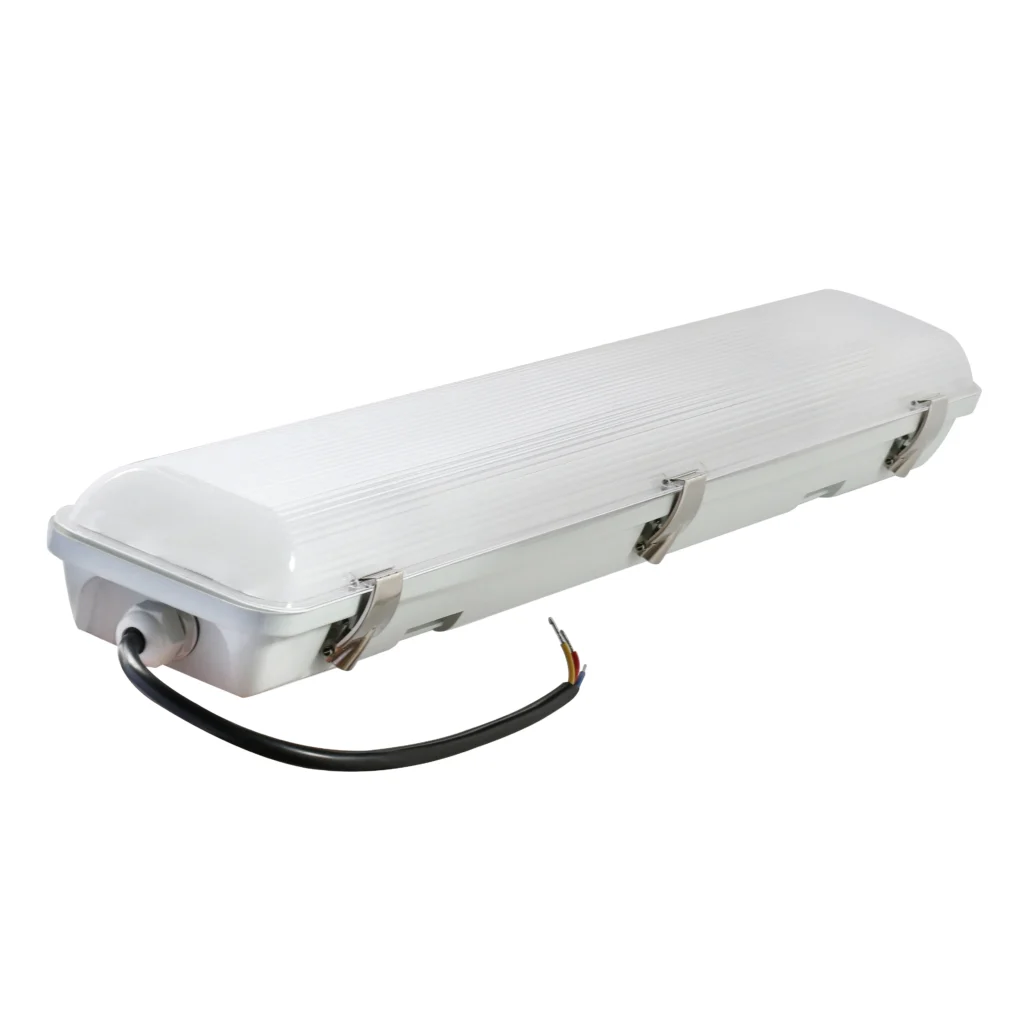
IP65/IP67 LED-Latte
Modell-Nr: TRA06x20F/TRA12x40F/TRA15x50F
Abmessung: 662/1272/1566x86x80mm
Eingangsspannung: 100-277VAC, 50/60Hz
Watt: 20W/40W/50W
Lichtausbeute: 150lm/W
CCT: 3000K, 4000K, 6500K
CRI: >80
IP-Bewertung: IP65/IP67
Dimmen: 0-10V/Triac/DALI/PWM
Zertifizierung: CE, RoHS
Garantie: 5Jahre
Im Vergleich zu IP65 stellen die Tri-Proof-Leuchten mit IP67-Bewertung einen erheblichen Fortschritt im Flüssigkeitsschutz dar, der speziell entwickelt wurde, um einem versehentlichen Untertauchen zu widerstehen und gleichzeitig das gleiche Staubwiderstandsniveau beizubehalten (vollständiger Staubschutz).
1. Wasserdichte Leistungs- und Testparameter
- Testmethode: Eintauchen in 1 Meter stilles Wasser, kein Wassereintritt für 30 Minuten.
- Praktische Bedeutung: Widersteht versehentlichem Eintauchen, Überschwemmungen oder vorübergehender Wasseransammlung.
2. Anwendungsumgebungen
IP67 LED-Tri-Proof-Leuchten eignen sich für feuchte, staubige Industrieanlagen wie Tiefgaragen und Badezimmer. Ihr staubdichtes und wasserdichtes Design widersteht Hochdruckwasserstrahlen und Staubeintritt und sorgt für einen stabilen Betrieb unter rauen Bedingungen.
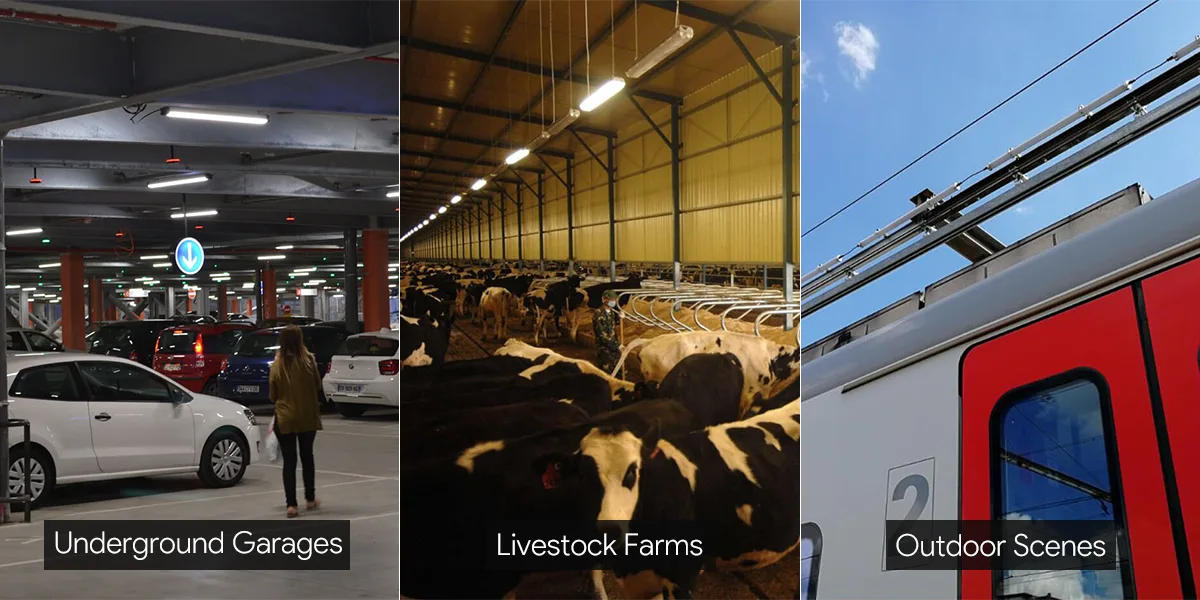
In der Landwirtschaft werden IP67-Tribonleuchten in feuchten Umgebungen wie Gewächshäusern und Viehfarmen weit verbreitet. Ihre versiegelte Konstruktion widersteht Wassernebel und Ammoniakkorrosion und erfüllt gleichzeitig die Notwendigkeit, das Pflanzenwachstum zu fördern oder die Produktion von Milchkuhmilch zu verbessern.
Außeneinstellungen wie Docks und Baustellen sind auch Hauptanwendungen für Tri-Proof-Leuchten mit IP67-Rating. Ihr schlagfestes und wetterfestes Design hält natürlichen Elementen wie Wind, Regen und Staub stand und sorgt für eine sichere und zuverlässige Beleuchtung.
3. Einschränkungen und Vorsichtsmaßnahmen
Tri-Proof-Leuchten mit IP67-Rating verwenden typischerweise spezielle Dichtungen, Dichtungen und Einkapselungstechniken, um das Eindringen von Wasser unter Eintauchbedingungen zu verhindern. Sie sind zwar für den Einsatz bei Regenwetter geeignet, aber nicht für den kontinuierlichen Unterwasserbetrieb oder Hochdruckstrahlwäsche ausgelegt (kann IP66-Tests nicht fehlen).
Was ist ein IP69K-Tri-Proof-Licht?
IP69K ist eine der höchsten Schutzwerte gemäß den Standards der International Electrotechnical Commission (IEC), speziell für Hochtemperatur- und Hochdruckreinigungsumgebungen. Es bedeutet höchste Schutzstufe gegen Staub und Wassereintritt, die so ausgelegt ist, dass sie extremen Reinigungsprozessen in industriellen Umgebungen standhält. Im Gegensatz zu IP67, das sich auf das Eintauchen konzentriert, bewältigen LED-DRI-Proof-Leuchten mit IP69K-Bewertung Hochdruck- und Hochtemperaturwaschprobleme.
Es ist wichtig zu beachten, dass IP69K nicht die Eintauchbeständigkeit von IP67 oder IP68 ersetzt. Es betont den Schutz gegen Hochdruckstrahlen, nicht längeres Eintauchen. Wenn Ihre Beleuchtung auf Eintauchen stoßen kann, sollten Sie sich daher auf die entsprechenden Schutzbewertungen konzentrieren.
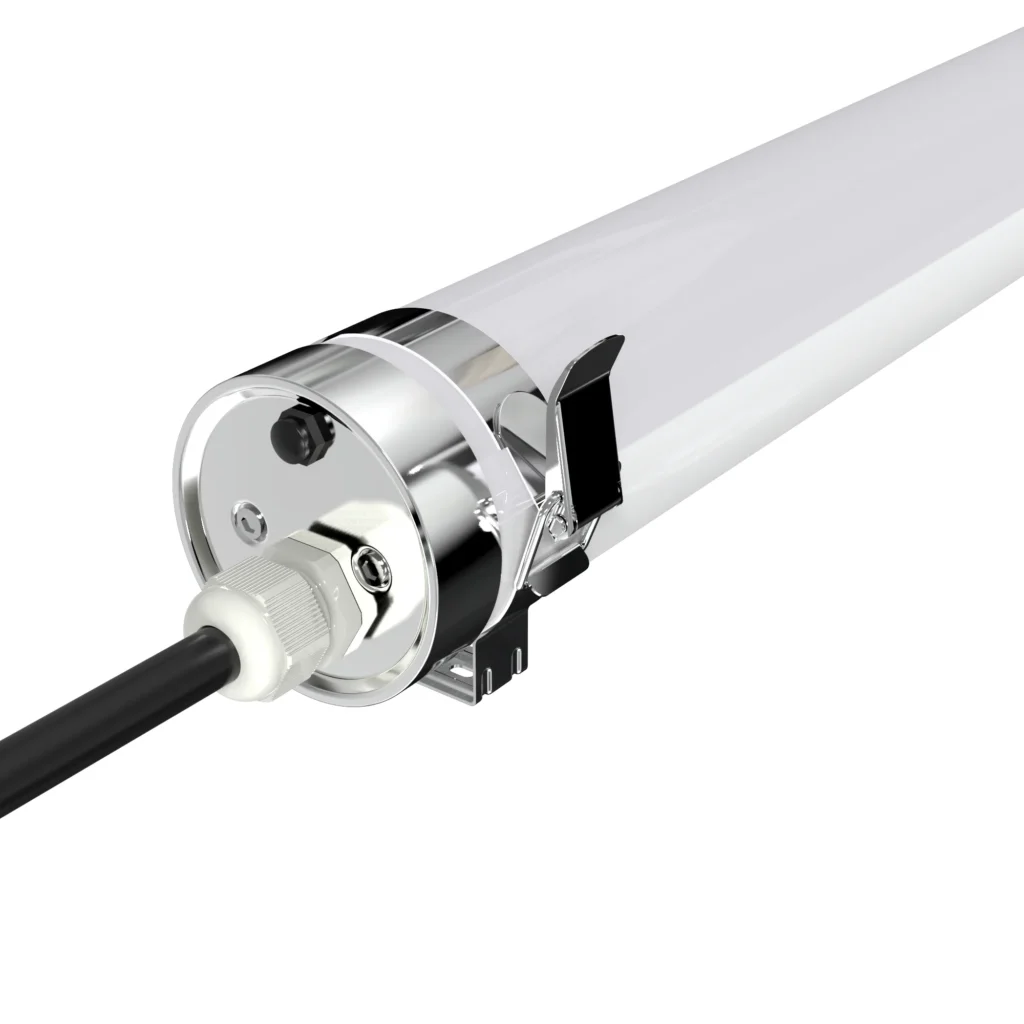
IP69K röhrenförmiges LED-Tri-Proof-Licht
Modell-Nr: TRC06X20F/TRC12X40F/TRC15X50F
Maß: Φ76×600/1200/1500mm
Eingangsspannung: 100-277VAC, 50/60Hz
Watt: 20W/40W/50W
Wirksamkeit: 130lm/W
CCT: 3000K, 4000K, 6500K
CRI: >80
IP-Bewertung: IP67/IP69K
Dimmen: 0-10V/Triac/DALI/PWM
Zertifizierung: CE, RoHS
Garantie: 5Jahre
1. Wasserdichte Leistungs- und Testparameter
- Prüfverfahren: Hochdruck (8000–10000 kPa / 80–100 bar), Hochtemperaturwasserstrahl (80°C) Düsenspezifikation: 14–16 Liter pro Minute bei 10–15 cm Abstand; Prüfmodi: 0°, 30°, 60° und 90° Winkel, jeweils 30 Sekunden.
- Praktische Bedeutung: Widersteht industriellen Reinigungsverfahren, Dampfreinigung und Protokollen zur sanitären Behandlung.
2. Anwendungsszenarien
IP69K LED-Tri-Proof-Leuchten sind für Lebensmittelverarbeitungslinien und Viehbetriebe geeignet, bei denen tägliche Hochdruck-Wasserstrahlen von 80°C ausgesetzt werden. Diese Leuchten bieten außergewöhnlichen Schutz vor Wasserabdichtung und Verschmutzung. Sie isolieren Feuchtigkeit vollständig und speisen Staub, verhindern Kurzschlüsse oder Korrosion durch Stromkreise und sorgen für einen kontinuierlichen und stabilen Betrieb in feuchten und heißen Umgebungen.
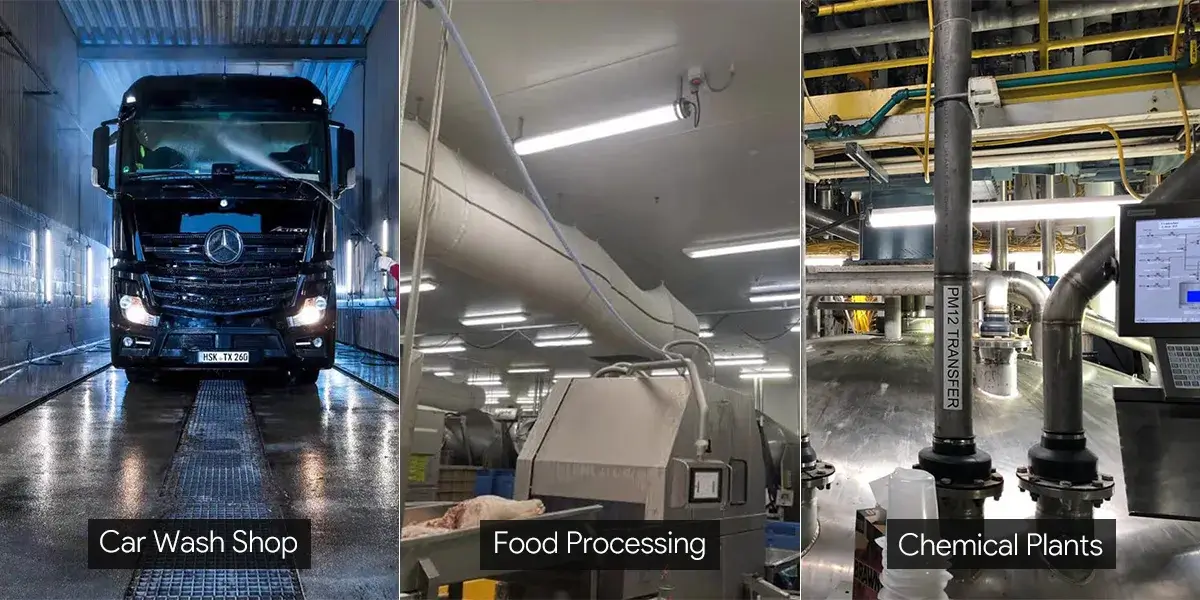
Die IP69K LED-Tri-Proof-Leuchten sind gleichermaßen für raue Außenumgebungen geeignet. Sie halten extremen Wetterbedingungen wie Regen, Schnee und Hitze stand. Sie werden häufig auf Parkplätzen, Tunneln und Gehwegen im Freien verwendet und bieten eine zuverlässige und effiziente Beleuchtung.
Die chemische und Korrosionsbeständigkeit von IP69K macht es ideal für die Pharma- und Gesundheitsbranche. Pharmazeutische Werkstätten stoßen häufig auf starke Säure- und Alkalidesinfektionsmittel, während Operationssäle-Instrumente eine Hochtemperatur-Dampfsterilisation erfordern. IP69K-Leuchten widerstehen effektiv chemischer Korrosion, während sie den Schutz des IP6X-Staubs beibehalten, das mikrobielle Wachstum eliminieren, das Kontaminationsrisiko reduzieren und die GMP-Sterilstandards einhalten.
Chemische Anlagen und Häfen sind mit Salzspray, saurem Regen und mechanischer Vibration konfrontiert. IP69K-Dreisichere Leuchten verfügen über verstärkte Strukturen (z. B. stoßfeste PC-Linsen) und Korrosionsschutzbeschichtungen, die die Dichteintegrität über -40°C bis 80°C Temperaturbereiche beibehalten, was die Wartungskosten im Freien erheblich senkt.
3. Wichtige Überlegungen:
- IP69K-bewertete Leuchten erfordern fortschrittliches Engineering und hochwertige Materialien.
- Spezielle Dichtungen behalten die Integrität unter hohem Druck und Temperatur.
- Edelstahl oder fortschrittliche Verbundwerkstoffe widerstehen Korrosion und thermischen Zyklen.
- Die Präzisionsfertigung eliminiert potenzielle Fehlerpunkte.
- Robuste, langlebige Komponenten sind im gesamten System integriert.
Auswahlhandbuch für IP65, IP67 und IP69K und vergleichende Analyse
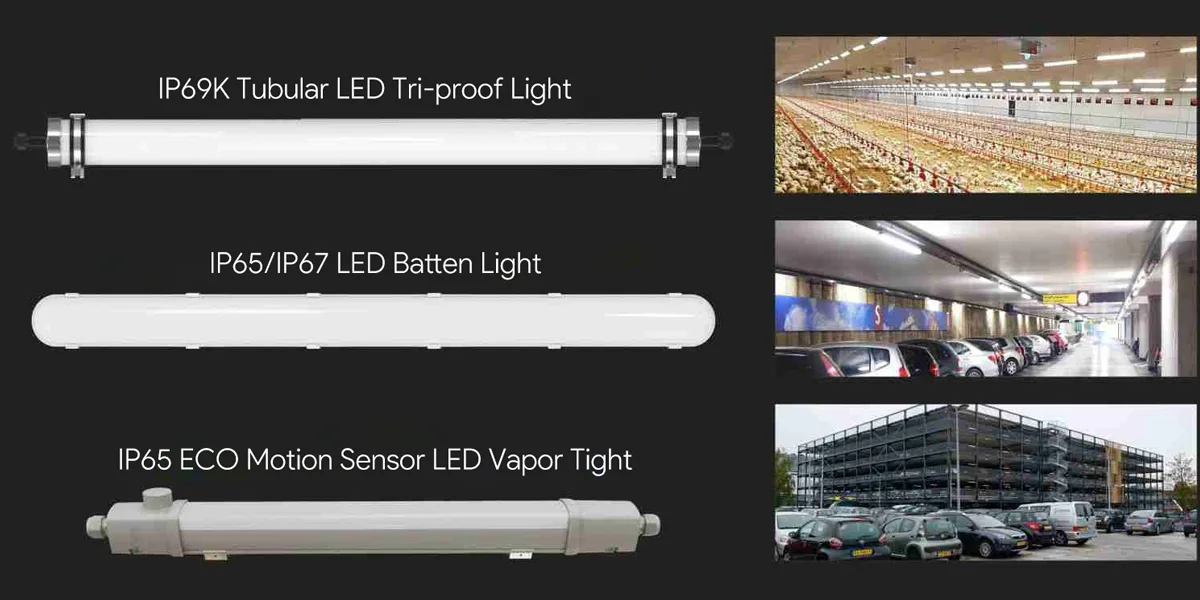
Auswahl der LED-TRI-Proof-Leuchte Zwischen IP65, IP67 und IP69K ist eine sorgfältige Bewertung Ihrer spezifischen Umgebung, Risikofaktoren und betrieblichen Anforderungen erforderlich. Der folgende Vergleichsanalyse- und Entscheidungsrahmen wird Ihren Auswahlprozess leiten.
1. Umfassender Vergleich von IP65, IP67 und IP69K
| Merkmal | IP65 | IP67 | IP69K |
| Staubschutz | Völlig staubdicht | Völlig staubdicht | Völlig staubdicht |
| Gewässerschutz | Niederdruckwasserstrahlen | Temporäres Eintauchen (1m/30min) | Hochdruck-, Hochtemperatur-Jets |
| Prüfdruck | 30 kPa | N/A (statisches Wasser) | 8.000-10.000 kPa |
| Ideal für | Außenbereiche, leichter Regen, Staub | Überschwemmungszonen, versehentliches Untertauchen | Industrielle Spülung, Desinfektion |
| nicht geeignet für | Druckwäsche, Eintauchen | Hochdruckstrahlen, kontinuierliches Eintauchen | N/A (Höchster Schutz) |
| Relative Kosten | Niedrig | Hoch | Höchste |
2. Auswahlkriterien und Entscheidungsrahmen
- Bewerten Sie den Expositionstyp für die Wasserexposition: Stellen Sie fest, ob Ihre Anwendung einen Spritzschutz (IP65/IP69K) oder eine Tauchbeständigkeit (IP67) erfordert.
- Bewerten Sie die Reinigungsprotokolle: Berücksichtigen Sie Druckniveaus, Temperaturen und Reinigungsfrequenz innerhalb der Geräte.
- Identifizieren Sie potenzielle Gefahren: Erkennen Sie unerwartete Expositionsrisiken über die normalen Betriebsbedingungen hinaus
- Die Gesamtbetriebskosten berücksichtigen: Erstinvestitionen mit möglichen Ausfallzeiten, Wartungs- und Ersatzkosten abgleichen.
- Überprüfen Sie die Industriestandards: Stellen Sie die Einhaltung sektorspezifischer regulatorischer Anforderungen sicher.
- Planen Sie die Installationsumgebung: berücksichtigen Sie Standortfaktoren wie Temperaturschwankungen, UV-Exposition und mögliche physikalische Auswirkungen.
3. Installation und Materialauswahl
Die ordnungsgemäße Installation und Wartung sind entscheidend für den Schutz der IP-Bewertung von IP-Leuchten. Wählen Sie zunächst streng Komponenten wie Steckverbinder und Armaturen aus, die der IP-Bewertung des Geräts entsprechen und die vom Hersteller festgelegten Dichtungsdrehmomentnormen einhalten, um Schwachstellen an der Quelle zu vermeiden.
Zweitens richten Sie einen systematischen Wartungsmechanismus ein. Führen Sie regelmäßige Inspektionen von Dichtungen und Dichtungen durch, führen Sie Pläne zur vorbeugenden Wartung durch, um die Alterung der Materialen zu behandeln und stellen Sie sicher, dass die Betriebs- und Reinigungsverfahren durch standardisierte Schulung der Mitarbeiter die Schutzanforderungen erfüllen. Dieser ganzheitliche Ansatz hält die langfristige Schutzwirkung der Ausrüstung aufrecht.
Die IP-Bewertungen spiegeln die Labortestbedingungen wider, die tatsächliche Leistung kann durch Dichtungsalterung, mechanische Beschädigung und unsachgemäße Wartung beeinträchtigt werden. Regelmäßige Inspektionen und vorbeugende Wartung sind entscheidend für die Aufrechterhaltung des Schutzniveaus im Laufe der Zeit.
Häufige Missverständnisse und Lösungen
Missverständnis 1: Blind die höchste Schutzklasse verfolgen
Viele Benutzer neigen dazu, bei der Auswahl von Tri-Proof-Leuchten die höchste Schutzart (z. B. IP69K) zu wählen, da sie glauben, dass höhere Bewertungen immer besser sind. Diese Wahl kann jedoch zu erhöhten Kosten führen. Tri-Proof-Leuchten mit hohen Schutzstufen sind in der Regel teurer, aber tatsächliche Nutzungsszenarien erfordern möglicherweise keine solch hohen Schutzstufen, was zu verschwendeten Ressourcen führt. Darüber hinaus kann es zu einer überarbeiteten Leistung kommen. Höhere Bewertungen können unnötige Designkomplexität (wie sperrigere Dichtungsstrukturen) verursachen, was möglicherweise die Wärmeableitung oder die Lichteffizienz der Leuchte beeinträchtigt.
Lösung: Definieren Sie die passenden Szenarien für unterschiedliche Schutzart und wählen Sie wasserdichte Leuchten mit der richtigen Bewertung, Ausgleichskosten und Leistung aus.
Missverständnis 2: Vernachlässigung der Auswirkungen von Installationsmethoden auf die Wirksamkeit des Schutzes
Auch bei hochbewerteten Leuchten mit IP-Bewertung kann eine unsachgemäße Installation (z. B. unzureichende Abdichtung oder falsche Winkel) noch Wasser oder Staub eindringen und den tatsächlichen Schutz verringern.
Häufige Probleme sind:
- Unzureichende Abdichtung: Bei der Montage nicht passende Dichtungen oder Gummistopfen zu verwenden, was zu Wasserlecks an den Verbindungen führt.
- Falscher Einbauwinkel: Wandmontage nicht nach Vorgaben gekippt, was zu Wasseransammlungen oder Staubansammlungen führt.
Lösung: Beachten Sie die Installationsrichtlinien, die doppellagigen Silikondichtungen an den Befestigungsverbindungen und die ausreichende Kompression von wasserdichten Stopfen (z. B. 0,5 mm) sicher. Führen Sie regelmäßige Wartungsinspektionen durch, um Staub und Schmutz zu entfernen und die Dichte zu überprüfen - insbesondere in Umgebungen mit hoher Luftfeuchtigkeit oder Korrosionsinfo.
Abschluss
Die Auswahl der geeigneten Schutzart für LED-Drei-Proof-Leuchten – ob IP65, IP67 oder IP69K – erfordert eine sorgfältige Berücksichtigung Ihrer spezifischen Umweltprobleme und betrieblichen Anforderungen.
Jede Schutzart dient verschiedenen Szenarien: IP65 passt zu allgemeinen Außenbereichen und staubgefährdeten Bereichen, IP67 übernimmt kurze Eintauchrisiken und IP69K ist für extrem saubere Umgebungen konzipiert.
Die korrekte Schutzart sorgt für einen zuverlässigen Betrieb der LED-Leuchten, reduziert die Wartungskosten, erhöht die Sicherheit und erweist sich als sinnvolle Wahl für die Steigerung der Betriebseffizienz und Produktivität. Es ist wichtig zu beachten, dass die Auswahl der richtigen Schutzbewertung nicht nur die anfänglichen Beschaffungskosten, sondern auch langfristige Ausgaben wie mögliche Ausfallzeiten, Wartungsgebühren und die Lebensdauer der Geräte ausbalanciert.
Signlited bietet eine komplette Palette von LED-Dreifachleuchten Entsprechend den oben genannten Schutzklassen, die zuverlässige Unterstützung für vielfältige Umweltprobleme durch intelligente, energieeffiziente Lichtlösungen bieten.
